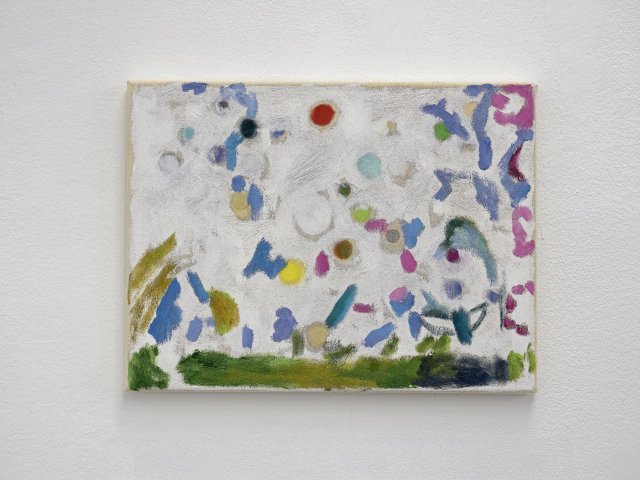Gritli Faulhaber: “Militant Joy (43)”, oil on canvas, 30 to 40 centimeters, 2024
Photo: Gritli Faulhaber/Neuer Essener Kunstverein
“Seek the extremes, that’s where all the action is.” This quote from the American painter, concept and performance artist Lee Lozano is on a painting by Gritli Faulhaber. Lozano, who turned away from the art company after a short but more intensive career, is considered Artist’s artist – one who wanted to know it and thus spur other artists.
Faulhaber’s artistic work is rich in references to feminist art history. In her painting, she unfolds a dense braid from picture quotes, visual references and allusions and spins a conceptual hyperimage – a hybrid picturesque montage from diverse image fragments. No picture stands for itself, everything arouses associations, shoots beyond himself, demands more knowledge and experience. Her painting breaks with generic conventions and fails over contradictions. Media reflection and emancipation go hand in hand. Nevertheless, this demanding, curious art does not tip into the scholarly pose, which is exhausted in the instructive display of art history knowledge.
Faulhaber’s painting retains something preliminary, sketchy, groping, searching and also unexcited. As if the canvases with all the painted fragments and references were direct extensions of the artist’s sketchbooks and workbooks. Private finds, suggestions for further work. “Now i’m ABLE to PAINT what you have processed photographer” – a quote from the artist colleague Maximiliane Baumgartner – is on another work, as if what was shown was just a modest step to clarify what this painting can. Not the gesture completed championship, but a painting in becoming, a learning process can be seen. “Which is why we now leave a big gap that has to be sufficient as a hint that this area is filled to the edge,” says Virginia Woolf’s “Orlando” (1928). Faulhaber’s sensitive handling of the image space is also characterized by comparable generosity.
Working work of the month
For Goethe, art is “a mediator of the unspeakable”. What is moving about it, what is political? We explain this using a current or historical example: the work of art of the month.
Thus, the quote mentioned by Lee Lozano also appears in a different light. Not the extreme transgressive border crossing, in excess, with all violence, are sought, rather it is about a maximum openness that finds its charm and new sensations everywhere. Since the world is dominated by “strong men” in politics and business, this can hardly be valued too high. “Militant Joy”, as Faulhaber names one of her continued series. These extremely reduced, small -format work arise in recurring phases in which the artistic area of action is extremely limited. The artist lives with ME/CFS, a severe neuroimmunological disease. The ability to paint like this becomes self -assertion towards your own body. As if it were about saying defiantly: “Now i’m die to paint what you will never process photographer.”
However, explaining these images solely from the condition of the disease would be shortened. They are much more than the documentation of distraction maneuvers or coping strategies. They are, but not only. Anyone who sees several paintings of the series side by side, as was possible until recently in the new Essen Kunstverein, will soon recognize the fine differences. Not everything works the same. The same tension cannot be seen everywhere. From stains, dabs, dots, lines and all sorts of traces, there is a rich spectrum of rudimentary gestures. Some things are thickened, others disintegrate. An order appears here, again not there. “Yes, the painting, the act of painting runs over chaos or the catastrophe,” as Gilles Deleuze noticed in his lectures “about painting” (1981), which also appeared in German translation at the beginning of the year.
Deleuze also wondered: »What happens if nothing emerges from it when the catastrophe spreads when it becomes a porridge? In certain cases you don’t have the impression that the painting fails? It happens again and again that painters fail, throw their paintings into the corner – very surprisingly, the whole thing. «For the philosopher, the examination of painting becomes a thinking about meaning and senselessness. The painter Maria Lassnig described it as follows: “The formation of the picture is dragged back and forth until the mysterious” point of certainty “comes to rest.”
It is understandable that painters have an increased interest in an “philosophy of painting” or at least an intensive thinking about their own practice in order to meet them with meaning and meaning. But what else can inclined newspaper readers pull out of such considerations? The history of art is full of learned interpretations that have set up in self -loving escapism. Constanted summons of art politics are often not much more convincing. And also the “militant Joy” to “do everything and to be able to do everything”, as the advocates of a rigorous freedom of art complain, is a symptom of offended liberalism. Then why devote themselves even more intensively to art advice? Maybe then so as not to become a cruise in this crazy world.
Or to practice the hinge: “to experience situations and circumstances”, “which are characterized because in them doing how to do its world, at least for moments have become problematic,” as Joseph Vogl writes. Perhaps it helps to further sensitize your own perception and sensitivity in order to counter the post-factual cynicism all around. Faulhaber’s painting offers the opportunity to escape capitalist purpose rationality at least for a few moments. It can’t be everything, but it is not nothing either.
judi bola online sbobet88 judi bola online sbobet88
